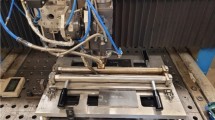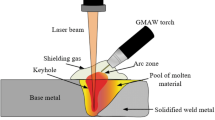Abstract
The study intended for rational usage of high-strength steel in structure by applying laser-arc hybrid welding has been conducted. Key design requirements and improvement target have been clarified considering their key performances as structural members. The evaluation methods for risk of brittle fracture and cold cracking have been established for quality control. Safety of welded joint has been confirmed and their fatigue strength has been improved by optimizing welding process.
















Similar content being viewed by others
References
Inose K, Nakanishi Y, Imoto I (2003) Study on design for extra high strength steel structure. Welding in the World 47(3-4):11–17
Inose Koutarou, Kanbayashi Junko, Abe Daisuke, Matsumoto Naoyuki,Yamaoka Hiroto (2012) Design and welding method for high strength steel structure using laser arc hybrid welding, Proceeding of NEDO Symposium 2nd, pp15-16
The Japan Welding Engineering Society (2007) Method of Assessment for Flaws in Fusion Welded Joints with respect to Brittle Fracture and Fatigue Crack Growth, WES2805
Minami F, Ohata M, Tanizawa A, Hagihara Y, Tukamoto S, Handa T, Inose K (2007) Significance of fracture toughness of laser welds for structure steels and fracture performance assessment by Weibull stress criterion. Quar J JWS 25(1):149–158
The Japan Welding Engineering Society (1995) Standard test method for Crack-Tip Opening Displacement (CTOD) fracture toughness measurement, WES1108
Inose K, Kanbayashi J, Abe D, Matsumoto N, Sugino T, Kim Y (2011) Improvement for fatigue strength of HT780 fillet welded joint using laser arc hybrid welding. Preprint Nat Meet of JWS 89:214–215
Japan Society of Steel Construction (1993) Fatigue Design Recommendations for Welded Structures
Miyaji T, Kiji N, Ogawa J-i, Ebihara T (2001) Field welding tests on cross section of box girder using thick plate for “Machiyagawa Bridge”. Ishikawajima Harima Engineering Review F0090A:176–183
Kim You-chul, Chung Yong-Dong, Hirohata Mikihito, Inose Koutarou (2012) Fatigue characteristics and evaluation in mechanics for cold cracking sensitivity of laser arc hybrid welded joints of high strength steel, Proceeding of NEDO Symposium 2nd, pp15-16
Inose Koutarou, Kanbayashi Junko, Abe Daisuke, Matsumoto Naouyuki, Kim You-chul, Hirohata Mikihito (2011) Experimental study for crack prevention of laser arc hybrid welding, Proceeding of welded structure symposium 2011, pp93–96
Acknowledgments
This study was carried out as a part of research activities of “Fundamental Studies on Technologies for Steel Materials with Enhanced Strength and Functions” by Consortium of The Japan Research and Development Center of Metals (JRCM). Financial support from New Energy and Industrial Technology Development Organization (NEDO) is gratefully acknowledged.
Author information
Authors and Affiliations
Corresponding author
Additional information
Doc. IIW-2382, recommended for publication by Commission XV “Design, Analysis, and Fabrication of Welded Structures.”
Rights and permissions
About this article
Cite this article
Inose, K., Kanbayashi, J., Abe, D. et al. Design and welding method for high-strength steel structure using laser-arc hybrid welding. Weld World 57, 657–664 (2013). https://doi.org/10.1007/s40194-013-0064-0
Received:
Accepted:
Published:
Issue Date:
DOI: https://doi.org/10.1007/s40194-013-0064-0




